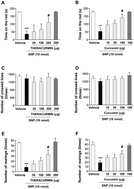Potential protective effect of highly bioavailable curcumin on an oxidative stress model induced by microinjection of sodium nitroprusside in mice brain
Abstract
Curcumin, a polyphenolic compound has several pharmacological activities, such as anticancer, anti-inflammatory and antioxidant effects. However, curcumin shows poor oral bioavailability. The purpose of this study was to investigate the protective effects of highly bioavailable curcumin, Theracurmin®, and curcumin, against sodium nitroprusside (SNP)-induced oxidative damage in mice brain. Intrastriatal microinjection of Theracurmin® or curcumin with SNP significantly protected against SNP-induced brain damage and motor dysfunction. Oral administration of Theracurmin® (1 and 3 g kg−1, containing 100 and 300 mg kg−1 curcumin, respectively) significantly protected against SNP-induced brain damage and motor dysfunction. However, oral administration of 300 mg kg−1 curcumin did not protect against motor dysfunction induced by SNP. These results suggest that curcumin and Theracurmin® have protective effects against SNP-induced oxidative damage. Moreover, oral administration of Theracurmin®, had more potency in protecting against brain damage, suggesting a higher bioavailability of Theracurmin® following oral administration.


 Please wait while we load your content...
Please wait while we load your content...